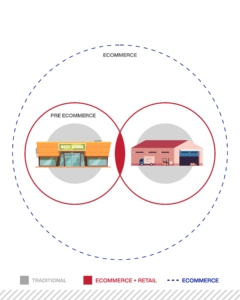The acceleration of e-commerce has led to a growing demand for rapid order fulfillment, making next-day delivery seem obsolete. With same-day delivery becoming the new standard, the pressure on the final mile to be as fast as possible is increasing. Retailers are thus resorting to new fulfillment measures such as Micro Fulfilment Centers (MFCs) as one of the most effective ways of meeting rising volumes.
As the name implies, MFCs are small distribution centers that come in different forms – designed as pickup or return stations, catering to the surge in ecommerce as they facilitate the delivery process. Much smaller and geographically closer to customers’ locations than traditional warehouses, MFCs are expected to reach $10 billion in market value by the year 2026. (Research and Markets)
How do MFCs facilitate same day delivery?
MFCs are in urban areas or within city limits (unlike traditional warehouses located on the outskirts of cities) with the purpose of shortening the fulfillment cycle times and reducing the distance between retailers and customers. Their geographical location also helps widening the pools of labor to warehouse workers who also live in or around the city and have no means of transportation. Besides location, MFCs are set up in 4 to 8 weeks, can easily fit into a wide range of supply chain strategies and have lower leasing and operating costs – making them extremely practical for retailers.
These small distribution hubs can be used to store time sensitive products such as fresh produce, medicine, event tickets or other goods expected to be delivered fast.
Same-day delivery thus becomes feasible and cost-effective through three main points.
- Urban presence, making delivery trips shorter and cheaper.
- Smaller sizes, making rent less expensive.
- Robotics and automation through which retrieval and picking becomes less costly.
What is the main driving factor behind MFCs’ growth?
As result of the pandemic, visiting stores is becoming less desirable, causing retailers an inability to fund stores and ultimately turning them into MFCs – where items are purchased online and either picked up from by customers, or delivered to them. This is leading to the merge of retail, distribution operations and property – which were seen as separate prior to the ecommerce era.
Pre ecommerce R D
Ecommerce and retail R D
Ecommerce RD

What are MFCs’ characteristics?
The lack of space availability in urban areas has forced businesses to be more flexible when choosing a fulfillment center. Retailers now find a suitable space, and fit operations into it – which is very different from the way sourcing property was done in the past, when retailers would acquire traditional warehouses (specifically designed for fulfillment purposes and in the 300,000 SF range). MFCs range between 5,000 and 25,000 SF, can be built as standalone facilities or be fitted into an existing location.
MFCs typically require a space, software management systems to process orders, and automated assets and robots for the picking and shuffling of goods, as well as manpower. All automated and robotic systems should be installed without expanding the facility, and should be able to cut the cost of filling an order by about 75%. (CB INSIGHTS)
Hub-and-spoke is a model of MFCs used by larger retailers, through which one main center serves a multitude of connecting hubs, which service different areas around the city. The shipment can then be distributed from this point, or warehoused. All packages are thus sorted at the main hub instead of multiple locations, sustainably reducing the margin for error and making freight more efficient.
Besides turning an entire store into a MFCs, retailers can make some room within their functioning shops. Referred to as Dark Stores, these MFCs are fitted into any facility with space to spare, such as the backside of stores, malls, supermarkets or basements – some businesses even turn parking lots into fulfillment hubs during nighttime. This model may provide limited inventory space, generally not being able to supply more than 24 to 48 hours’ worth of operations. It however enables retailers to offer e-commerce customers the same products available in store.
Retailers are now moving towards a reduction of manual labor and an increase in automation by integrating robots and AI technologies for different functions within MFCs such as picking or shuffling. As old technology no longer suits the current era of fulfillment, new robots and systems are being created to better adapt to the new landscape of operations in MFCs.



